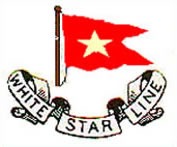The White Star Line
 The White Star Line was first founded in Liverpool in 1850 by John Pilkington and Henry Threlfall Wilson.
The White Star Line was first founded in Liverpool in 1850 by John Pilkington and Henry Threlfall Wilson.
It was a sound company, but the original ships known as clipper ships eventually became water soaked, overstrained and slow.
They just needed a plan to meet modern day requirements.
White Star Line was sold in 1867 to business partners Sir Edward Harland and Thomas Henry Ismay. Their intent was to build faster, longer lasting iron ships and continue in the shipping trade market.
A good relationship was soon formed between White Star and the reputable Belfast shipbuilders, Harland and Wolff.
Harland and Wolff would build the ships to their own specifications, sparing no expense, they would then tack on a fixed percentage to the building cost to constitute their fee.
Further agreement stated that Harland and Wolff would never build a ship for any of White Star’s competitors, and at the same time White Star would never contract a rival shipbuilder.
In 1869 Thomas Ismay created the Oceanic Stream Navigation company that would open trade to the Atlantic.
The creation of the Teutonic won the ship and White Star the Blue Ribband award for setting a speed record for crossing the Atlantic. This was the incentive that Ismay needed to expand his company.
Competition arose ands all eyes were focused on White Star. Many people believed that White Stars greatest triumph was the Oceanic.
The first class accommodations were placed amidships, unlike other ships that had them placed at the stern where engine noise and vibration were present. A grand dining saloon was added, with promenades on deck. It also featured running water and electricity in the passenger cabins.
In 1985 Sir Edward Harland passed away, shortly followed by Thomas Dismay who died in 1899. John Bruce Ismay succeed his fathers position with in the company.
With a new owner, a new partnership would take place – between Bruce Ismay and the new Harland and Wolff chairman, Lord W.J. Pirrie.
By the early 1900’s, the shipping companies were in a state of a vicious price rate war which was hurting all parties involved. American financier and multi-millionaire John Pierpont Morgan saw this as a tremendous opportunity to expand his capital. Morgan was a railroad, coal and steel magnate and decided to turn his interest to the Atlantic shipping trade. Morgan decided to buy up all these rival shipping companies and place them under one controlling trust with fixed shipping prices. He called this trust the International Mercantile Marine, or IMM.
The British shipping companies considered this a definite threat to their business, and the formation of IMM inspired the Cunard line to make a move, and fast. Hence the birth of Cunard’s greatest achievements, the Lusitania and the Mauritania. These two ships would be the largest and fastest ships the world had ever seen.
The Lusitania quickly grabbed the famed Blue Ribband award for setting a transatlantic crossing speed record. These ships played a vital role in convincing Cunard’s rival White Star Line to accept Morgan’s buyout proposal, especially when he offered them 10 times the shipping line’s earnings for the year 1900. An additional agreement by the Morgan trust said that the White Star ships would remain reserves for the British Navy and could be requisitioned by the Admiralty in case the need arose. A smart inclusion to the deal, with England but a few years from entering the Great War.
In 1902 the deal had been made final. Ismay would remain managing director and chairman of White Star. Morgan later convinced him to assume the presidency of IMM. This meant that his company would build all of the ships for all of the individual lines that fell under the IMM trust, and under the same agreement that had existed before.
Ismay and Pirrie decided that something was going to have to be done about the competition that was begining to hold a threat for them.
After meeting one night for dinner in 1907, Ismay and Pirrie came up with an idea of building two twin leviathans that would be even larger than the Cunard ships, enabling them to carry more passengers and freight. As well, these ships that would feature the last word in luxury rather than speed. A third ship was to later join this special group called the “Olympic Class Liners.” In fact the first ship would be named Olympic. The second ship would be named Titanic and the third, Gigantic. Gigantic was later renamed to Britannic in remembrance to the Titanic disaster.
